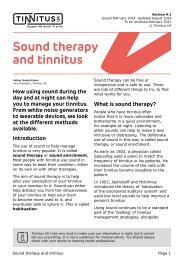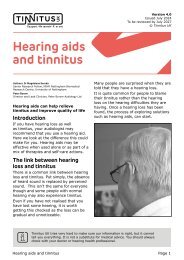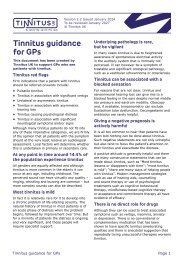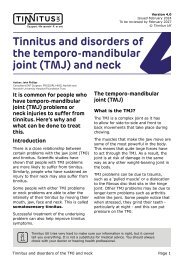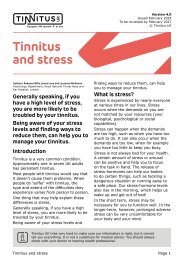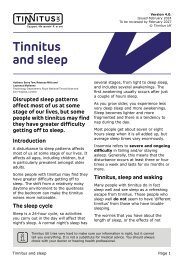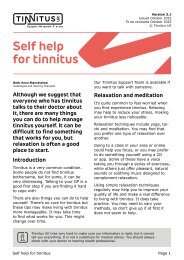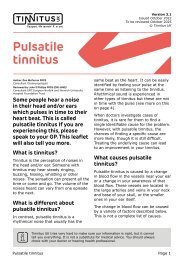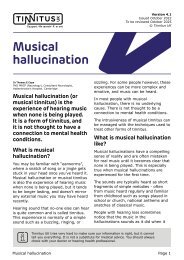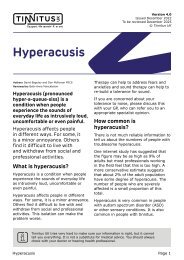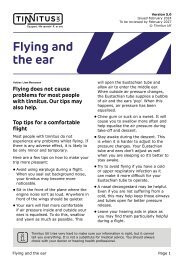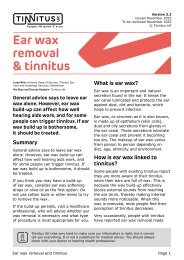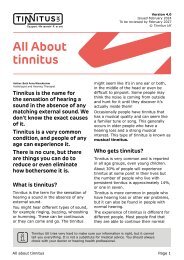ATRR 2018 Five years later FINAL
You also want an ePaper? Increase the reach of your titles
YUMPU automatically turns print PDFs into web optimized ePapers that Google loves.
ANNUAL<br />
TINNITUS<br />
RESEARCH<br />
REVIEW<br />
<strong>2018</strong><br />
FIVE YEARS LATER:<br />
What happened after the James<br />
Lind Alliance Tinnitus Priority<br />
Setting Partnership<br />
Nic Wray<br />
Annual Tinnitus Research Review <strong>2018</strong>
Annual Tinnitus Research Review <strong>2018</strong>.<br />
Copyright © British Tinnitus Association <strong>2018</strong>.<br />
Editors: Deborah Hall & Nic Wray<br />
The editors would like to thank all the contributors<br />
for their support and enthusiasm. We would also<br />
like to thank the copyright owners of the images<br />
and figures reproduced in this publication for<br />
their permission to reproduce them either directly<br />
or via licence. We believe that all such work has<br />
been acknowledged, but please contact Nic Wray<br />
on nic@tinnitus.org.uk if any acknowledgements<br />
have been inadvertently omitted.<br />
British Tinnitus Association<br />
Unit 5 Acorn Business Park<br />
Woodseats Close<br />
Sheffield<br />
S8 0TB<br />
www.tinnitus.org.uk<br />
info@tinnitus.org.uk<br />
0114 250 9933<br />
Registered charity no. 1011145. Company limited<br />
by guarantee no. 2709302, registered in England.
FIVE YEARS LATER:<br />
What happened after the James<br />
Lind Alliance Tinnitus Priority<br />
Setting Partnership<br />
NIC WRAY<br />
Communications Manager<br />
British Tinnitus Association<br />
Nic has been Communications Manager at the<br />
BTA since June 2010. She is responsible for the<br />
BTA’s communications online and in print as well<br />
as being one half of the PR team. In addition to<br />
writing a number of the BTA’s information leaflets,<br />
she also edits the BTA’s journal, Quiet and co-edits<br />
the Annual Tinnitus Research Review. She sees<br />
providing the tinnitus community with information<br />
as a key to helping people live well with tinnitus. A<br />
graduate of the University of Sheffield, she is an<br />
Accredited PR Practitioner and a member of the<br />
Chartered Institute of Public Relations.<br />
ACKNOWLEDGMENTS<br />
During 2016 and 2017, a series of articles rounding<br />
up developments in research appeared in Quiet, the<br />
journal of the British Tinnitus Association. These<br />
were written by Paul Chinnock and were invaluable<br />
in the writing of this review.<br />
Nic Wray<br />
Introduction<br />
The James Lind Alliance (JLA) was established<br />
in 2004 to bring patients, carers and clinicians<br />
together to identify and prioritise the unanswered<br />
questions about treatments that they agree<br />
are most important. These priorities may not<br />
necessarily be the same as those considered<br />
important by researchers and commercial<br />
interests, and so the purpose is to bring the<br />
‘minority’ voice to drive the research agenda.<br />
Priority Setting Partnerships (PSP) work together<br />
to gather uncertainties about the effects of<br />
treatments. The uncertainties are all checked<br />
to ensure they cannot be answered by existing<br />
knowledge, research or sources of information.<br />
The JLA Tinnitus PSP began in October 2011.<br />
The initial founders were the British Tinnitus<br />
Association, the NIHR Nottingham Hearing<br />
Biomedical Research Unit (now the NIHR<br />
Nottingham Biomedical Research Centre) and<br />
the Judi Meadows Memorial Fund, with a wider<br />
working partnership of 56 UK stakeholders<br />
representing professional organisations, charities<br />
and patient support groups.<br />
The priority setting process produced a final top<br />
ten clinical research questions (Table 1, column 1)<br />
[1], which demonstrates the breadth of research<br />
required to develop a better understanding<br />
of tinnitus, the need for a cure as well as the<br />
requirement to better understand and determine<br />
the effectiveness of existing treatments.<br />
Working in consultation with the Professional<br />
Advisers’ Committee of the BTA, the partnership<br />
also published ideas for future research<br />
Annual Tinnitus Research Review <strong>2018</strong>
<strong>Five</strong> <strong>years</strong> <strong>later</strong><br />
Uncertainty in the diagnosis,<br />
assessment and treatment of tinnitus<br />
What management strategies are more<br />
effective than a usual model of audiological<br />
care in improving outcomes for people with<br />
tinnitus?<br />
Is Cognitive Behaviour Therapy (CBT), delivered<br />
by audiology professionals, effective for people<br />
with tinnitus? Here comparisons might be with<br />
usual audiological care or CBT delivered by a<br />
psychologist.<br />
What management strategies are more<br />
effective for improving tinnitus-related<br />
insomnia than a usual model of care?<br />
Do any of the various available complementary<br />
therapies provide improved outcome for people<br />
with tinnitus compared with a usual model of<br />
care?<br />
What type of digital hearing aid or amplification<br />
strategy provides the most effective tinnitus<br />
relief?<br />
What is the optimal set of guidelines for<br />
assessing children with tinnitus?<br />
How can tinnitus be effectively managed in<br />
people who are Deaf or who have a profound<br />
hearing loss?<br />
Are there different types of tinnitus and can they<br />
be explained by different mechanisms in the ear<br />
or brain?<br />
Annual Tinnitus Research Review <strong>2018</strong><br />
Suggested research strategy<br />
1. Studies comparing effects of different management strategies in<br />
reducing the functional impact of subjective idiopathic tinnitus and<br />
improving quality of life. Proceeding to:<br />
2. Timely systematic review of the evidence from clinical trials.<br />
1. Studies evaluating CBT and/or other psychological counselling<br />
approaches delivered by appropriately trained audiology professionals.<br />
1. A study comparing the effects of different management strategies<br />
specifically aimed at improving sleep for patients with tinnitus and<br />
insomnia, including CBT as one arm of the research design.<br />
1. Studies comparing different complementary therapies for improving<br />
functional outcomes for people with subjective idiopathic tinnitus and<br />
compared with the usual model of care. Studies should consider those<br />
complementary therapies that have been shown to be beneficial in<br />
treating other chronic health conditions. Proceeding to:<br />
2. Timely systematic review of the evidence from clinical trials.<br />
1. Studies to determine whether digital hearing aids are effective<br />
in reducing the functional impact of subjective idiopathic tinnitus.<br />
Proceeding if necessary to:<br />
2. Parallel activities comprising:<br />
i. Studies evaluating the effects of different amplification strategies<br />
for people with subjective idiopathic tinnitus<br />
ii. Studies evaluating the effects of different hearing aid devices,<br />
including digital combination devices (hearing aid and sound masker) as<br />
one arm of the trial<br />
iii. Timely systematic review of the evidence from clinical trials.<br />
1. Parallel activities comprising:<br />
i. A systematic approach to gain consensus among a multidisciplinary<br />
panel of experts about the most appropriate assessment methods and<br />
diagnostic criteria for children with tinnitus<br />
ii. Development of an evidence-based algorithm/pathway to aid<br />
clinical diagnosis based on existing research<br />
iii. Development of a systematic form of national data collection<br />
from existing services to provide an evidence base that would inform<br />
development of guidelines.<br />
1. Parallel activities comprising:<br />
i. Studies to evaluate the effects of non-audiological tinnitus<br />
interventions in reducing tinnitus symptoms for people with profound<br />
hearing loss and tinnitus<br />
ii. A systematic review of the effects of multichannel intra-cochlear<br />
implants to suppress tinnitus. Proceeding if necessary to:<br />
2. Development of new treatment approaches for people with profound<br />
hearing loss or deafness and tinnitus.<br />
1. Identification of:<br />
i. Meaningful criteria for tinnitus subtyping<br />
ii. The underpinnings of the different tinnitus subtypes in humans in<br />
terms of inner ear pathology and neurobiology and;<br />
iii. Their relevance for response to various treatments. Proceeding if<br />
necessary to:<br />
2. Development of an evidence-based algorithm/pathway to guide<br />
patient assessment, diagnosis and management.
<strong>Five</strong> <strong>years</strong> <strong>later</strong><br />
Uncertainty in the diagnosis,<br />
assessment and treatment of tinnitus<br />
What is the link between tinnitus and<br />
hyperacusis (over-sensitivity to sounds)?<br />
Which medications have proven to be effective<br />
in tinnitus management compared with<br />
placebo?<br />
Suggested research strategy<br />
1. A systematic review of the association between tinnitus and<br />
hyperacusis, including epidemiological data. Proceeding if necessary to:<br />
2. Understanding the underpinnings of tinnitus and hyperacusis in terms<br />
of inner ear pathology and neurobiology.<br />
1. Systematic reviews of the other classes of drugs that are prescribed to<br />
alleviate tinnitus and/or associated symptoms. Proceeding if necessary<br />
to:<br />
2. Studies of drug treatments for reducing tinnitus symptoms, including<br />
reduced perception of the tinnitus sound.<br />
Table 1:<br />
Top ten research uncertainties and suggestions for research strategies<br />
strategies to address each uncertainty (Table 1,<br />
column 2) [2].<br />
The research community was challenged to take<br />
on these uncertainties and to use the questions<br />
to devise high-quality research projects [1,2].<br />
This article attempts to provide a summary of the<br />
research carried out since the publication of the<br />
top ten uncertainties which addresses each of<br />
the priorities.<br />
What management strategies are more effective<br />
than a usual model of audiological care in<br />
improving outcomes for people with tinnitus?<br />
The usual model of audiological care is to provide<br />
education and support for tinnitus, with the<br />
provision of digital hearing aids for managing<br />
tinnitus with a hearing loss, and other forms of<br />
sound therapy, as required [3].<br />
Research is continuing into modifications of<br />
existing management strategies such as sound<br />
therapies and relaxation techniques. Whilst some<br />
of these studies show that such interventions<br />
are effective [4][5], there has been no strategy<br />
demonstrating a leap forward in effectiveness.<br />
Indeed, some studies have concluded that no<br />
significant improvements occur [6] or that it is<br />
not better than standard care [7].<br />
The possible exception to this mindfulness. A<br />
Mindfulness Based Cognitive Therapy study<br />
led by Dr Laurence McKenna and Dr Liz Marks<br />
has demonstrated that the technique is more<br />
effective – and the results longer lasting – than<br />
relaxation techniques [8]. More details of this<br />
study can be found elsewhere in this review<br />
series.<br />
Studies into transcranial direct current<br />
stimulation (tDCS) have had variable results and<br />
systematic reviews have been contradictory [9]<br />
[10].<br />
People who receive a cochlear implant for hearing<br />
problems often report that their implant has<br />
reduced their tinnitus [11]. Using implants which<br />
provide environment sounds give a similar benefit<br />
to standard implants [12].<br />
Currently in press is a review into tinnitus apps<br />
with the aim of giving users and clinicians a more<br />
informed choice about the best app for tinnitus<br />
management [13].<br />
In addition to clinician-led management, selfhelp<br />
programmes are used by people with<br />
tinnitus to reduce the impact of the condition.<br />
A systematic review [14] identified the selfhelp<br />
techniques used by adults with chronic<br />
tinnitus and assessed their effectiveness. <strong>Five</strong><br />
previous studies reported eight self-management<br />
components and behaviour change techniques,<br />
but the effectiveness of these could not be stated<br />
with any certainty.<br />
Annual Tinnitus Research Review <strong>2018</strong>
<strong>Five</strong> <strong>years</strong> <strong>later</strong><br />
Figure 1:<br />
Acupuncture<br />
Is Cognitive Behaviour Therapy (CBT), delivered<br />
by audiology professionals, effective for people<br />
with tinnitus? Here comparisons might be with<br />
usual audiological care or CBT delivered by a<br />
psychologist.<br />
Psychological approaches to tinnitus treatment<br />
are a popular management strategy and subject<br />
for research. A recent review [15] found there<br />
have been over 5,000 studies. Very little of this<br />
research has involved RCTs so the quality of the<br />
evidence available is not high.<br />
A pilot RCT aimed to evaluate the feasibility of<br />
comparing a psychologically informed guidance<br />
manual developed to support audiologist<br />
management of tinnitus with usual treatment<br />
is currently underway. The study will assess the<br />
acceptability of the counselling intervention,<br />
compliance and whether there is sufficient<br />
interest and need for a full RCT [16].<br />
What management strategies are more effective<br />
Annual Tinnitus Research Review <strong>2018</strong><br />
for improving tinnitus-related insomnia than a<br />
usual model of care?<br />
Sleep disturbance affects over one half of<br />
people attending tinnitus clinics [17]. Cognitive<br />
Behavioural Therapy [CBT] has been shown to<br />
help manage insomnia and CBT for insomnia<br />
(CBTi) is now part of the NICE guidelines for the<br />
management of long-term insomnia [18]. In a BTA<br />
-commissioned study, Dr Laurence McKenna and<br />
Dr Liz Marks are investigating the effectiveness of<br />
CBTi as a treatment for tinnitus-related insomnia<br />
[19].<br />
Do any of the various available complementary<br />
therapies provide improved outcome for people<br />
with tinnitus compared with a usual model of<br />
care?<br />
Whilst there have been a number of systematic<br />
reviews into complementary therapies and<br />
dietary supplementation, the number of studies<br />
eligible for consideration is generally small, and<br />
often considered to be of low quality and at risk of<br />
bias [20].<br />
A systematic review into acupuncture for tinnitus<br />
found a total of 18 RCTs, half of them performed
<strong>Five</strong> <strong>years</strong> <strong>later</strong><br />
in China and half elsewhere [21]. Nearly all the<br />
Chinese studies reported positive results, whilst<br />
most studies from other countries had negative<br />
findings. The reviewers were unable to conclude<br />
whether acupuncture is or is not an effective<br />
treatment for tinnitus.<br />
There is no evidence that electroacupuncture,<br />
in which electrical stimulation is applied via<br />
acupuncture needles, works [22].<br />
Ginkgo biloba has been investigated over many<br />
<strong>years</strong> for potential benefit in tinnitus. An updated<br />
Cochrane Review in 2013 concluded that the<br />
limited evidence offered did not demonstrate that<br />
Ginkgo biloba is effective for tinnitus where this is<br />
the primary complaint [23].<br />
What type of digital hearing aid or amplification<br />
strategy provides the most effective tinnitus<br />
relief?<br />
Published in 2014, a Cochrane Review [24] to<br />
examine the evidence that already exists about<br />
hearing aid interventions for tinnitus with hearing<br />
loss found only one previous trial. This highlights<br />
the need for further research in this area. Dr<br />
Magdalena Sereda – in a post funded by the<br />
BTA – is researching the clinical efficacy of NHS<br />
contracted sound therapy options for tinnitus<br />
including hearing aids and combination hearing<br />
aids [25]. A Delphi review was conducted as a<br />
pre-cursor to this work, and this suggests a lack<br />
of consensus among clinicians with regard to<br />
fitting hearing aids for patients presenting with<br />
tinnitus and a mild hearing loss [26].<br />
Researchers in Germany fitted patients with<br />
hearing aids which delivered sounds from which<br />
a ‘notch’ of frequency had been removed [27].<br />
This technique was called notched environmental<br />
sound technology [NEST]. A control group<br />
received hearing aids only. Whilst the NEST<br />
group showed more improvement, the difference<br />
between the two groups was not statistically<br />
significant. Similarly, a trial [6] conducted using<br />
notched music without amplification showed<br />
no significant improvement levels in tinnitus<br />
measured by questionnaire.<br />
Figure 2:<br />
Tinnitus activity book for children [32]<br />
Two types of sound were compared in a small<br />
trial [28] in which 17 patients heard conventional<br />
‘technical’ sounds through their hearing aids<br />
and 20 were chosen from a selection of ‘nature<br />
sounds’. They all completed THI questionnaires<br />
before treatment began and after three and<br />
six months. Tinnitus Handicap Inventory (THI)<br />
scores improved after treatment in both groups,<br />
but there was no significant difference between<br />
groups. There was no control group.<br />
What is the optimal set of guidelines for<br />
assessing children with tinnitus?<br />
The Paediatric Audiology Interest Group (PAIG) of<br />
the British Society of Audiology (BSA) formed a<br />
working party of national specialists in paediatric<br />
tinnitus in response to the challenge posed by the<br />
JLA tinnitus PSP. They published the Tinnitus in<br />
Children: Practice Guidance document in March<br />
2015 [29].<br />
Annual Tinnitus Research Review <strong>2018</strong>
<strong>Five</strong> <strong>years</strong> <strong>later</strong><br />
The practice guidance was written using the<br />
available evidence base, and from the clinical<br />
experience and practice of the working party<br />
members.<br />
A number of other resources for professionals<br />
working with children with tinnitus have<br />
subsequently been developed. These include<br />
a training course [30] and award-winning<br />
information [31] and activity booklets for children<br />
[32].<br />
Ms Harriet Smith – in a PhD Studentship funded<br />
by the BTA – is now developing a questionnaire<br />
measure of tinnitus in children.<br />
How can tinnitus be effectively managed in<br />
people who are Deaf or who have a profound<br />
hearing loss?<br />
The BTA commissioned The Ear Foundation to<br />
investigate people’s experiences with tinnitus and<br />
severe/profound hearing loss. Their report [33]<br />
presented the views of over 1,400 people with<br />
varying degrees of hearing loss on the treatment<br />
they received, what was effective, and their hopes<br />
for the future. Forty-four per cent of those with<br />
severe/profound hearing loss classed tinnitus<br />
as a severe problem. This impacted on stress,<br />
relationships, concentration and attention, and<br />
sleep. Those with severe/profound hearing loss<br />
had the greatest impact from tinnitus, but were<br />
less likely to receive help and more likely to be<br />
discharged. For those receiving professional<br />
care, it was reported that professional advice<br />
may be insensitive – for example, suggestions<br />
to use maskers or sound therapy – with the<br />
concentration being on the hearing loss and not<br />
the tinnitus.<br />
Twenty-three people who had received a<br />
cochlear implant for hearing loss in one ear in the<br />
previous three to ten <strong>years</strong> were interviewed and<br />
completed standard Tinnitus Questionnaires [11]<br />
All patients switched on their implants on waking<br />
and used them throughout the day. Seventy<br />
per cent said that their tinnitus level decreased<br />
within one minute of switching them on. Scores<br />
from the questionnaires showed improvement<br />
Annual Tinnitus Research Review <strong>2018</strong><br />
in tinnitus typically began three months after<br />
implantation and then remained stable. This is<br />
not a rigorous experimental study, but the results<br />
are encouraging.<br />
Several studies have explored the benefit of<br />
cochlear implantation in people with severely<br />
impaired hearing in one ear and moderate<br />
to normal hearing in the other (single-sided<br />
deafness). Arts et al 2016 [12] investigated<br />
whether an implant that was programmed<br />
to deliver tinnitus suppressing sounds would<br />
have greater benefit than a standard algorithm<br />
optimised for speech perception. Tinnitus<br />
reduced in both cases, with no difference<br />
between.<br />
Another type of implant called a percutaneous<br />
osseointegrated auditory implant has also been<br />
investigated [34]. These implants are inserted<br />
through the skin and integrated into bone tissue.<br />
Ten patients with single-sided hearing loss were<br />
given implants in the deaf ear. Most showed an<br />
improvement in their tinnitus, particularly those<br />
with the most profound hearing loss.<br />
Are there different types of tinnitus and can they<br />
be explained by different mechanisms in the ear<br />
or brain?<br />
The heterogeneity of tinnitus – explored by<br />
other articles in this review – is often cited<br />
as a stumbling block for developing effective<br />
treatment approaches. There is no agreed<br />
classification and so perhaps a new approach<br />
is required. Eleni Genitsaridi and Theo Kypraios<br />
present progress on this topic, in thisreview<br />
series.<br />
What is the link between tinnitus and<br />
hyperacusis (over-sensitivity to sounds)?<br />
Between 40 and 60% of patients with tinnitus<br />
report hyperacusis, a decreased tolerance<br />
to sound [17][39][40] although it has been<br />
estimated to be as high as 80% [41]. The frequent<br />
appearance of both these conditions in the same<br />
individual is suggestive of a common mechanism<br />
[42].
<strong>Five</strong> <strong>years</strong> <strong>later</strong><br />
Researchers used the Tinnitus Research<br />
Initiative (TRI) database to compare clinical<br />
and demographic data of tinnitus patients with<br />
and without tinnitus [40]. Hyperacusis with<br />
tinnitus was associated with younger patients,<br />
higher levels of tinnitus-related, mental and<br />
general distress; higher tinnitus pitch in relation<br />
to measured tinnitus pitch; worse subjective<br />
hearing; greater influence on tinnitus from<br />
external factors; and higher rates of pain<br />
disorders and vertigo, leading the authors to<br />
conclude that there is an over-activation of some<br />
unspecified network in these patients. Based<br />
on animal research; Knipper et al proposed a<br />
putative universal model for the mechanisms<br />
of tinnitus and hyperacusis [43] whilst<br />
acknowledging that there may be a range of<br />
such mechanisms. They suggested that tinnitus<br />
and hyperacusis may be associated with various<br />
degrees of deafferentation (the interruption or<br />
destruction of inward connections of nerve cells);<br />
differences in central gain; or abnormal stress<br />
effects that may act in the cochlear periphery.<br />
Which medications have proven to be effective<br />
in tinnitus management compared with<br />
placebo?<br />
Jufa and Wood carried out a systematic review<br />
to assess the effectiveness of benzodiazepines<br />
against tinnitus [44]. Although the number of<br />
studies was small and some were of poor quality,<br />
the researchers concluded that there is no<br />
evidence to support the use of diazepam, and<br />
only weak evidence for the use of clonazepam.<br />
Ciodaro et al combined gabapentin with<br />
lidocaine injections given just under the skin of<br />
the ear canal [42]. Seventy-two patients were<br />
randomly allocated to receive gabapentin only,<br />
gabapentin plus lidocaine, or placebo treatment.<br />
The improvement in THI scores was significantly<br />
higher in the gabapentin group than in the control<br />
group, and those in the gabapentin plus lidocaine<br />
group did significantly better than those receiving<br />
gabapentin alone. An Iranian study [43] also<br />
showed improvement in tinnitus for patients<br />
given gabapentin compared to a control group<br />
but commented on the ‘remarkable’ placebo<br />
effect.<br />
Kumral et al performed a double-blinded RCT into<br />
trimetazidine dihydrochloride [44] .There were no<br />
significant differences between the treatment<br />
and control groups after treatment, leading to<br />
the conclusion that trimetazidine dihydrochloride<br />
offers no benefits for people with tinnitus.<br />
Zinc is known to play a role in the functioning of<br />
the ear. A Cochrane systematic review of studies<br />
using zinc supplementation [45] found only three<br />
RCTs, only once of which had used a validated<br />
scale for tinnitus. This study found that 5% of the<br />
patients given zinc showed benefit, compared<br />
to 2% of the control group who also improved.<br />
The remaining studies also found no significant<br />
differences between treatment and control<br />
groups.<br />
Intratympanic membrane injections have<br />
been attracting some interest. The steroid<br />
dexamethasone was used on 27 patients,<br />
with 27 others in the control group receiving a<br />
Figure 3:<br />
Medication<br />
Annual Tinnitus Research Review <strong>2018</strong>
<strong>Five</strong> <strong>years</strong> <strong>later</strong><br />
Figure 4:<br />
Tinnitus cure road map<br />
saline injection. There was some improvement<br />
in both groups, but there was no significant<br />
difference between them [46]. An initial safety<br />
study of intratympanic injections of esketamine<br />
hydrochloride (AM-101) showed some limited<br />
promise [57]. A larger multi-centre double-blind<br />
placebo controlled trial however only showed<br />
improvements in patients following noiseinduced<br />
hearing loss or after middle ear infection<br />
[48] and Phase III studies were ended after initial<br />
results showed no significant improvements<br />
between treatment groups and control groups<br />
[49].<br />
Mapping a cure<br />
Whilst the research above is undoubtedly of<br />
value, the overwhelming cry from people living<br />
with tinnitus is that they want a cure. The BTA’s<br />
vision is for ‘a world where no one suffers from<br />
tinnitus’. Pivotal to that aim is working towards<br />
an ultimate cure for tinnitus. As part of that<br />
aspiration, the BTA has instituted a series<br />
Annual Tinnitus Research Review <strong>2018</strong><br />
of strategic work streams, one of which is<br />
specifically aimed at achieving a cure.<br />
The first step in this process has been to take<br />
stock of what has been achieved to date and<br />
what current research is being conducted.<br />
To try and identify areas where gaps in our<br />
knowledge are hampering progress, the BTA has<br />
developed a mind map which synthesises the<br />
position of current tinnitus research [Figure 4]<br />
[50].<br />
It is hoped that by being able to see where our<br />
knowledge is deficient, we can more effectively<br />
apportion research resources. This should also<br />
help to ensure that research funding is not<br />
directed towards areas that have already been<br />
fully explored. This project is an update and<br />
follow-up to the JLA Tinnitus PSP which focused<br />
purely on treatments and outcomes.<br />
The mind map is a complex diagram, reflecting<br />
the complex and heterogeneous nature of
<strong>Five</strong> <strong>years</strong> <strong>later</strong><br />
tinnitus, and the uncertainties that still exist<br />
about causes, mechanisms and management.<br />
The map is split into five different groups,<br />
representing the big themes that will need to be<br />
addressed before a cure can be declared. These<br />
over-arching themes are then broken down into<br />
general areas of research which are then further<br />
divided into specific research topics, individual<br />
projects and further subdivisions.<br />
Work is still ongoing to further refine the mind<br />
map, with contributions having been sought<br />
from the wider tinnitus community, including<br />
clinicians, patients and researchers.<br />
Conclusion<br />
It is important that more research into tinnitus<br />
is carried out, but it needs to be of good quality.<br />
A systematic review by US researchers [51]<br />
examined aspects of study quality in tinnitus<br />
RCTs and found that in over half of the trials,<br />
researchers had failed to define specifically how<br />
they defined ‘tinnitus’, and only 20% of trials had<br />
a low risk of bias. It is a common theme of the<br />
recent systematic reviews undertaken in the<br />
tinnitus field that there have been insufficient<br />
studies of good enough quality for inclusion.<br />
However, whilst many studies have been<br />
inconclusive, the trend over the last five <strong>years</strong><br />
has been for increasing numbers of positive<br />
results from studies. This review has shown<br />
that there is much to be celebrated and much<br />
progress has been made since the publication of<br />
the Top Ten Priorities. From scattered nuggets of<br />
clinical experience have come a whole suite of<br />
resources for those clinicians, parents and young<br />
people dealing with tinnitus in childhood, and an<br />
increased acceptance and interest in paediatric<br />
tinnitus.<br />
There is a real drive to explore and evaluate<br />
existing tinnitus management techniques and<br />
introduce novel technologies and interventions.<br />
It will be interesting to see where the next five<br />
<strong>years</strong> takes us in addressing the challenges<br />
the JLA Tinnitus PSP threw out to the tinnitus<br />
research community.<br />
References<br />
[1] British Tinnitus Association. The James Lind<br />
Alliance Tinnitus Priority Setting Partnership, 2012.<br />
Available from http://www.jla.nihr.ac.uk/prioritysetting-partnerships/tinnitus/<br />
[2] Hall D, Mohamad N, Firkins L, Fenton M and<br />
Stockdale D, Identifying and prioritizing unmet<br />
research questions for people with tinnitus: the<br />
James Lind Alliance Tinnitus Priority Setting<br />
Partnership. Clinical Investigation. 2013: 3(1): 21-<br />
28, doi: 10.4155/cli.12.129<br />
[3] Baguley D, McFerran D and Hall D. Tinnitus.<br />
The Lancet. 2013: 382: 1600-07, doi: 10.1016/<br />
S0140-6736(13)60142-7<br />
[4] Folmer RL, Theodoroff SM, Martin WH and Shi, Y.<br />
Experimental, controversial, and futuristic<br />
treatments for chronic tinnitus. Journal of the<br />
American Academy of Audiology. 2014: 25[1]: 106-<br />
125(20)<br />
[5] Makar SK, Mukundan G, Gore G. Treatment of<br />
Tinnitus: a scoping review. The International<br />
Tinnitus Journal. 2017: 21[2]: 144-156<br />
[6] Stein A, Wunderlich R and Lau P. Clinical trial on<br />
tonal tinnitus with tailor-made notched music<br />
training. BMC Neurology. 2016: 16: 38<br />
[7] Henry JA, Stewart BJ, Griest S, Kaelin C, Zaugg<br />
TL and Carlson K. Multisite randomised control trial<br />
to compare two methods of tinnitus intervention<br />
to two control conditions. Ear and Hearing. 2016:<br />
37(6): e346-e359<br />
[8] McKenna L, Marks EM, Hallsworth CA and<br />
Schaette R. Mindfulness-Based Cognitive Therapy<br />
as a treatment for chronic tinnitus: a randomized<br />
control trial. Psychotherapy and Psychosomatics.<br />
2017: 86(6): 351-361 doi: 10.1159/000478267<br />
[9] Wang TC, Tyler RS, Chang TY, Chen JC, Lin CD,<br />
Chung HK and Tsou YA. Effect of Transcranial<br />
Direct Current Stimulation in patients with tinnitus:<br />
a meta-analysis and systematic review. Annals of<br />
Otology, Rhinology and Laryngology. <strong>2018</strong>: 127(2):<br />
79-88. doi: 10.1177/0003489417744317<br />
[10] Song JJ, Vanneste S, Van de Heyning P and<br />
De Ridder D. Transcranial direct current stimulation<br />
in tinnitus patients: a systemic review and metaanalysis.<br />
Scientific World Journal. 2012: 427941<br />
doi: 10.1100/2012/427941. Epub 2012 Oct 17.<br />
[11] Mertens G, De Bodt M and van de Heyning P.<br />
Cochlear implantation as a long term treatment<br />
for ipsi<strong>later</strong>al hearing loss up to 10 <strong>years</strong>.<br />
Hearing Research. 2016: 331: 1-6. doi: 10.1016/j.<br />
heares.2015.09.016<br />
Annual Tinnitus Research Review <strong>2018</strong>
<strong>Five</strong> <strong>years</strong> <strong>later</strong><br />
[12] Arts R, George E, Janssen M et al. Tinnitus<br />
suppression by intracochlear electrical stimulation<br />
in single sided deafness – a prospective clinical<br />
trial: follow-up. PLoS One. 2016: 11: e015313<br />
[13] British Tinnitus Association. BTA Head of Research<br />
[online]. Available from https://www.tinnitus.org.<br />
uk/bta-head-of-research [last accessed 20 June<br />
<strong>2018</strong>]<br />
[14] Greenwell K, Sereda M, Coulson N, El Refaie<br />
A and Hoare DJ. A systematic review of techniques<br />
and effects of self-help interventions for tinnitus:<br />
application of taxonomies from health psychology.<br />
International Journal of Audiology. 2016 55: sup3:<br />
S79-S89, DOI: 10.3109/14992027.2015.1137363<br />
[15] Thompson DM, Hall DA, Walker DM and Hoare DJ.<br />
Psychological therapy for people with tinnitus:<br />
a scoping review of treatment components. Ear<br />
and Hearing. 2017: 38(2): 149-158. doi: 10.1097/<br />
AUD.0000000000000363<br />
[16] Taylor JA, Hall DA, Walker DM, McMurran M et<br />
al. A psychologically informed, audiologistdelivered,<br />
manualised intervention for tinnitus:<br />
protocol for a randomised controlled feasibility trial<br />
(Tin Man study). Pilot and Feasibility Studies. 2017<br />
3: 24 doi: 10.1186/s40814-017-0137-8<br />
[17] Fioretti AB, Fusetti M and Eibenstein A. Association<br />
between sleep disorders, hyperacusis and tinnitus:<br />
evaluation with tinnitus questionnaires. Noise<br />
and Health. 2013: Mar-Apr 15(63): 91-5. doi:<br />
10.4103/1463-1741.110287<br />
[18] National Institute for Health and Care<br />
Excellence. Insomnia – Scenario: Managing longterm<br />
insomnia [online]. Available from https://cks.<br />
nice.org.uk/insomnia#!scenario:1 (last accessed<br />
20 March <strong>2018</strong>)<br />
[19] British Tinnitus Association. Volunteers needed for<br />
tinnitus and insomnia study [online]. Available from<br />
https://www.tinnitus.org.uk/volunteers-neededfor-tinnitus-and-insomnia-study<br />
(last accessed 20<br />
March <strong>2018</strong>)<br />
[20] Coelho C, Tyler R, Ji H, Rojas-Roncancio E, Witt S,<br />
Tao P, Jun HJ, Wang TC, Hansen MR and Gantz<br />
BJ. Survey on the effectiveness of dietary<br />
supplements to treat tinnitus. American Journal of<br />
Audiology. 2016: 25(3): 184-205<br />
[21] Liu F, Han X, Li Y and Yu S. Acupuncture in the<br />
treatment of tinnitus: a systematic review<br />
and meta-analysis. European Archives of<br />
Otorhinolaryngology. 2016: Feb 273(2): 285-94.<br />
doi: 10.1007/s00405-014-3341-7. Epub 2014 Oct<br />
25<br />
[22] He M, Li X, Liu Y et al. Electroacupuncture for<br />
tinnitus: a systematic review. PloS ONE. 2016:<br />
11[3]: e0150600<br />
[23] Hilton MP, Zimmermann EF and Hunt WT.<br />
Ginkgo biloba for tinnitus. Cochrane database of<br />
systematic reviews. 2013: 3. Art. No.: CD003852.<br />
DOI: 10.1002/14651858.CD003852.pub3.<br />
[24] Hoare DJ, Edmondson-Jones M, Sereda M, Akeroyd<br />
MA and Hall D. Amplification with hearing aids for<br />
patients with tinnitus and co-existing hearing loss.<br />
Cochrane database of systematic reviews. 2014:<br />
Jan 31:(1): CD010151. doi: 10.1002/14651858.<br />
CD010151.pub2<br />
[25] British Tinnitus Association. BTA Head of<br />
Research [online]. Available from https://www.<br />
tinnitus.org.uk/bta-head-of-research (last<br />
accessed 20 March <strong>2018</strong>)<br />
[26] Sereda M, Hoare DJ, Nicholson R, Smith S and Hall<br />
DA. Consensus on hearing aid candidature<br />
and fitting for mild hearing loss, with and<br />
without tinnitus: Delphi review. Ear and Hearing.<br />
2015: Jul-Aug 36(4): 417-29. doi: 10.1097/<br />
AUD.0000000000000140<br />
[27] Strauss DJ, Corona-Strauss FI, Seidler H, Haab L<br />
and Hannemann R. Notched environmental<br />
sounds: a new hearing aid-supported tinnitus<br />
treatment evaluated in 20 patients. Clinical<br />
Otolaryngology. 2017: Feb 42(1): 172-175. doi:<br />
10.1111/coa.12575. Epub 2016 Feb 11<br />
[28] Barozzi S, Del Bo L, Crocetti A , Dyrlund O et al. A<br />
comparison of nature and technical sounds for<br />
tinnitus therapy. Acta Acoustica 2016 102[3]: 540-<br />
546 doi: 10.3813/AAA.918971<br />
[29] British Society of Audiology. Tinnitus in children:<br />
practice guidance [online]. Available from<br />
http://www.thebsa.org.uk/wp-content/<br />
uploads/2015/03/2015-Paed-Tin-Guidelines-<br />
<strong>FINAL</strong>.pdf [last accessed 20 March <strong>2018</strong>)<br />
[30] British Tinnitus Association. Assessment and<br />
management of tinnitus in children [online].<br />
Available from https://www.tinnitus.org.uk/Event/<br />
paediatrictinnitus (last accessed 20 March <strong>2018</strong>)<br />
[31] Lawrence S and Smith K. Ellie, Leila and Jack have<br />
tinnitus; Tinnitus (Key stage 2); Tinnitus (Key stages<br />
3-4). British Tinnitus Association 2015<br />
[32] Wray N and Smith K. Ellie, Leila, Jack and me<br />
have tinnitus; Tinnitus activity book (Key stage<br />
2); Tinnitus activity book (Key stages 3-4). British<br />
Tinnitus Association 2016<br />
[33] Zheng YN, Archbold S, Harrigan S and Mulla I.<br />
Conspiring together: tinnitus and hearing loss.<br />
Annual Tinnitus Research Review <strong>2018</strong>
<strong>Five</strong> <strong>years</strong> <strong>later</strong>ch<br />
British Tinnitus Association. Available from https://<br />
www.tinnitus.org.uk/conspiring-together-tinnitusand-hearing-loss<br />
(last accessed 20 March <strong>2018</strong>)<br />
[34] Indeyeva YA, Diaz A, Imbrey T et al. Tinnitus<br />
management with percutaneous osseointegrated<br />
auditory implants for uni<strong>later</strong>al sensorineural<br />
hearing loss. American Journal of Audiology. 2015:<br />
24: 398-410<br />
[35] Henry JA, Roberts LE, Caspary DM, Theodoroff SM<br />
and Salvi RJ. Underlying mechanisms of tinnitus:<br />
review and clinical implications. Journal of the<br />
American Academy of Audiology. 2015 25: 5-22<br />
doi: 10.3766/jaaa25.1.2<br />
[36] The Hyperacusis Network. What is hyperacusis?<br />
[online] Available from http://www.hyperacusis.<br />
net/what-is-it/ (last accessed 20 March <strong>2018</strong>)<br />
[37] Schecklmann M, Landgrebe B, Langguth B et al.<br />
Phenotypic characteristics of hyperacusis in<br />
tinnitus. PLoS ONE. 2014 doi: 10.1371/journal.<br />
pone.0086944<br />
[38] Dauman R and Bouscau-Faure F. Assessment and<br />
amelioration of hyperacusis in tinnitus patients.<br />
Acta Oto-laryngologica. 2005: May 125(5): 503-9<br />
[39] Nelson JJ and Chen K. The relationship of tinnitus,<br />
hyperacusis, and hearing loss. Ear, Nose and<br />
Throat Journal. 2004: Jul 83(7): 472-6<br />
[40] Knipper M, Van Dijk P, Nunes I, Rüttiger L and<br />
Zimmermann U. Advances in the neurobiology of<br />
hearing disorders: Recent developments regarding<br />
the basis of tinnitus and hyperacusis. Progress in<br />
Neurobiology. 2013: 111: 17-33<br />
[41] Jufa S and Wood R. The use of benzodiazepines<br />
for tinnitus: systematic review. Journal of<br />
Laryngology and Otology. 2015: 129 (suppl3): S14<br />
[42] Ciodaro F, Mannella VK, Cammaroto G et al. Oral<br />
gabapentin and intradermal injection of<br />
lidocaine: is there any role in the treatment of<br />
moderate/severe tinnitus? European Archives of<br />
Otorhinolaryngology. 2015: 272: 2825-2830<br />
[43] Goljanian TA, Safavi NA and Baradaran N. Shortterm<br />
effect of gabapentin on subjective tinnitus<br />
in acoustic trauma patients. Iranian Journal of<br />
Otorhinolaryngology. 2017: 29(91): 95-100<br />
[44] Kumral TL, Yildirim G, Berkiten G et al. Efficacy of<br />
trimetazidine dihydrochloride for relieving chronic<br />
tinnitus: a randomised double-blind study. Clinical<br />
and Experimental Otorhinolaryngology. 2016: 9(3):<br />
192-197<br />
[45] Person OC, Puga ME, da Silva EM and Torloni MR.<br />
Zinc supplementation for tinnitus. Cochrane<br />
database of systematic reviews. 2016 Nov 23: 11:<br />
CD0009832<br />
[46] Choi SJ, Lee JB, Lim HJ, In SM et al. Intratympanic<br />
dexamethasone injection for refractory<br />
tinnitus: prospective placebo-controlled study.<br />
Laryngoscope. 2013: Nov 123(11): 2817-22. doi:<br />
10.1002/lary.24126<br />
[47] Muehlmeier G, Biesinger E and Maier H. Safety<br />
of intratympanic injection of AM-101 in patients<br />
with acute inner ear tinnitus. Audiology and<br />
Neuro-otology. 2011: 16(6): 388-97. doi:<br />
10.1159/000322641<br />
[48] van de Heyning P, Muehlmeier G, Cox T,<br />
Lisowska G et al. Efficacy and safety of<br />
AM-101 in the treatment of acute inner ear<br />
tinnitus--a double-blind, randomized, placebocontrolled<br />
phase II study. Otology and Neurootology.<br />
2014: Apr 35(4): 589-97. doi: 10.1097/<br />
MAO.0000000000000268<br />
[49] Auris Medical. Auris Medical provides business<br />
update [online]. Available from<br />
http://ir.aurismedical.com/phoenix.<br />
zhtml?c=253572&p=irol-newsArticle&ID=2337919<br />
(last accessed 20 March <strong>2018</strong>)<br />
[50] Carr, D. Mapping a cure. Quiet. 2017: 28(4): 17-20<br />
[51] Plein CT, Harounian J, Floyd E, Irizarry R, Ferzli G<br />
et al. A systematic review of eligibility and<br />
outcomes in tinnitus Trials. Otolaryngology–Head<br />
and Neck Surgery. 2016: 154[1]<br />
Annual Tinnitus Research Review <strong>2018</strong>




